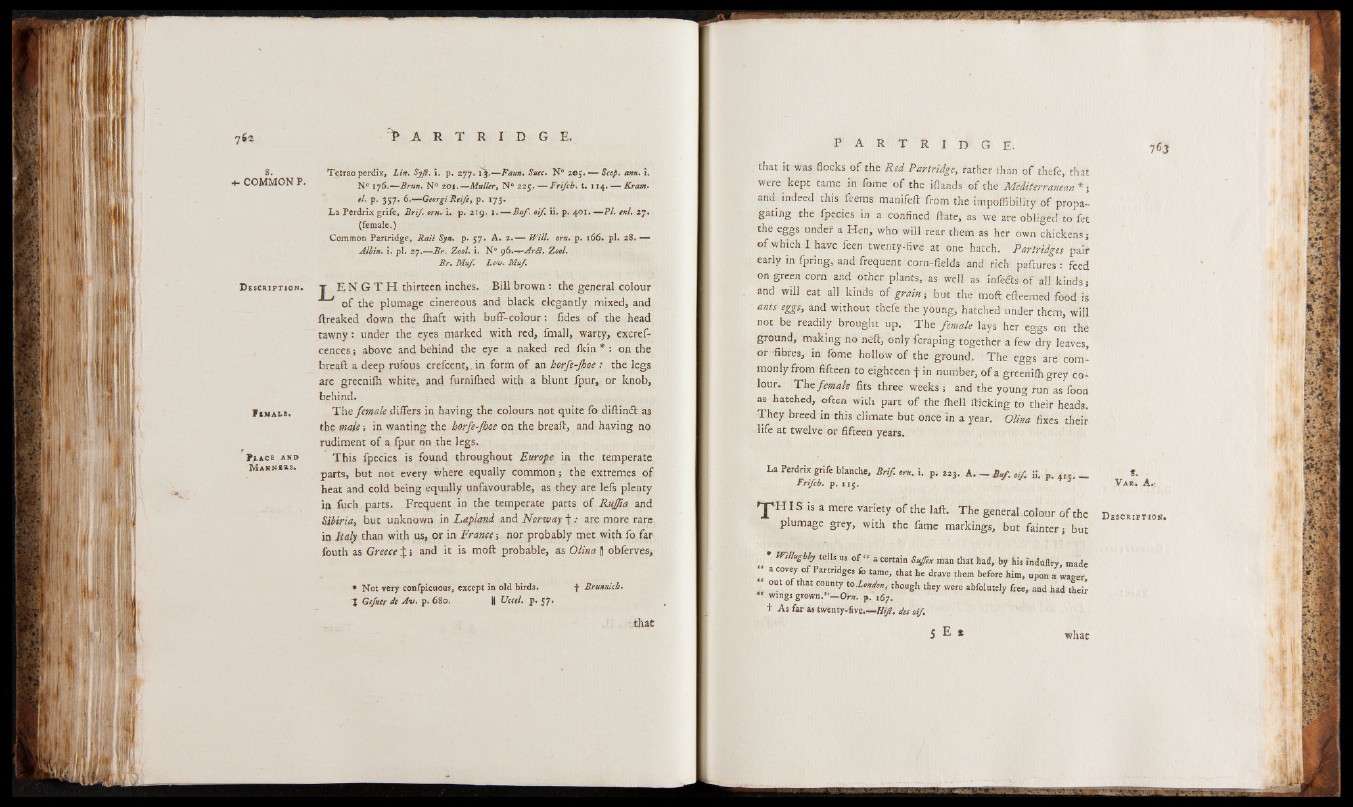
7 $ 2 > A R T R I 0 G E.
+■ 8. COMMON P.
Teirao perdix, Lift. Syjt. i. p. zyy , v^.— Faun, Suec. N° 205. Scop, anti, i,
N° \y6.— Brun. N° 201.—Muller, N° 225. — Frifcb. t. 114. — Krarn*
el. p. 357. 6.— Georgi Reife> p. 173.
La Perdrix grife, Brif. orn. i. p. 219. 1 . -— Buf. o if ii. p. 401. — P i. enl.
(female.)
Common Partridge, R a il Syn. p. 57. A. 2.«— Will. orn. p. 166. pi. 28. —
Albin. i. pi. zy .— B r . Zool. i. N° g6.-*-Arft. Zool.
B r . Muf. Lent. Muf.
D escription* T E N G T H thirteen inches. Bill brown : the general colour
o f the plumage cinereous and black elegantly mixed, and
flreaked down the lhaft with buff-colour: fides of the head
taw ny: under the eyes marked with red, fmall, warty, excref-
cences; above and behind the eye a naked red Ikin * : on the
breaft a deep rufous crefcenf,. in form of an horfe-Jhoe: the legs
are greenilh white, and furnilhed with a blunt fpur, or knob,
behind.
F emale. The female differs in having the colours not quite fo diftinft as
the mafe -, in wanting the herfe-Jboe on the breaft, and having no
Place and
Manners*
rudiment o f a fpur on the legs.
T his fpecies is found throughout Europe in the temperate
parts, but not every where equally com m on; the extremes of
heat and cold being equally unfavourable, as they are lefs plenty
In fuch parts. Frequent in the temperate parts o f Raffia and
Sibiria, but unknown in Lapland and Norway f ■' are more rare
in Italy than with us, or in France; nor probably met with fo far
fouth as Greece J ; and it is moft probable, as Olina || obferves,
* Not very conlpicuous, except in old birds. -J- Brunnich.
t Gefntr de Av. p. 680, H Uccel. p. 57.
that
that it was flocks of the Red Partridge, rather than of thefe, that
were kept tame in fome of the iflands of the Mediterranean* j
and indeed this feems manifeft from the impoffibility of propagating
the fpecies in a confined ftate, as we are obliged to fet
the eggs under a Hen, who will rear them as her own chickens;
of which I have feen twenty-five at one hatch. Partridges pair
early in fpring, and frequent corn-fields and rich paftures : feed
on green corn and other plants, as well as infefts of all kinds;
and will eat all kinds of grain; but the moft efteemed food is
ants eggs, and without thefe the young, hatched under them, will
not be readily brought up. The female lays her eggs on the
ground, making no neft, only fcraping together a few dry leaves,
or -fibres, in fome hollow of the ground. The eggs are commonly
from fifteen to eighteen f in number, of a greenilh grey co-
lour. The female fits three weeks ; and the young run as foon
as hatched, often with part of the lhell flicking to their heads.
They breed in this climate but once in a year. Olina fixes their
life at twelve or fifteen years.
*.
V ar. A.-
D escription*
La Perdrix grife blanche, Brif. m . i. p. 223. A. — Buf. olf. ii. p. Ate,—
Frifcb. p. 115.
TH1f is a mere varietf of the laft. The general colour of the
plumage grey, with the fame markings, but fainter; but
Wdlughiy tells us of " a certain Suffex man that had, by His induftry. made
• a covey of Partridges fo tame, that he drave them before him, upon a wager
“ ° “* of that though they were abfolutely free, and had their
wings grown.”— Orn. p. 167.
+ As far as twenty-five.—-By?, due!/.
S E * what